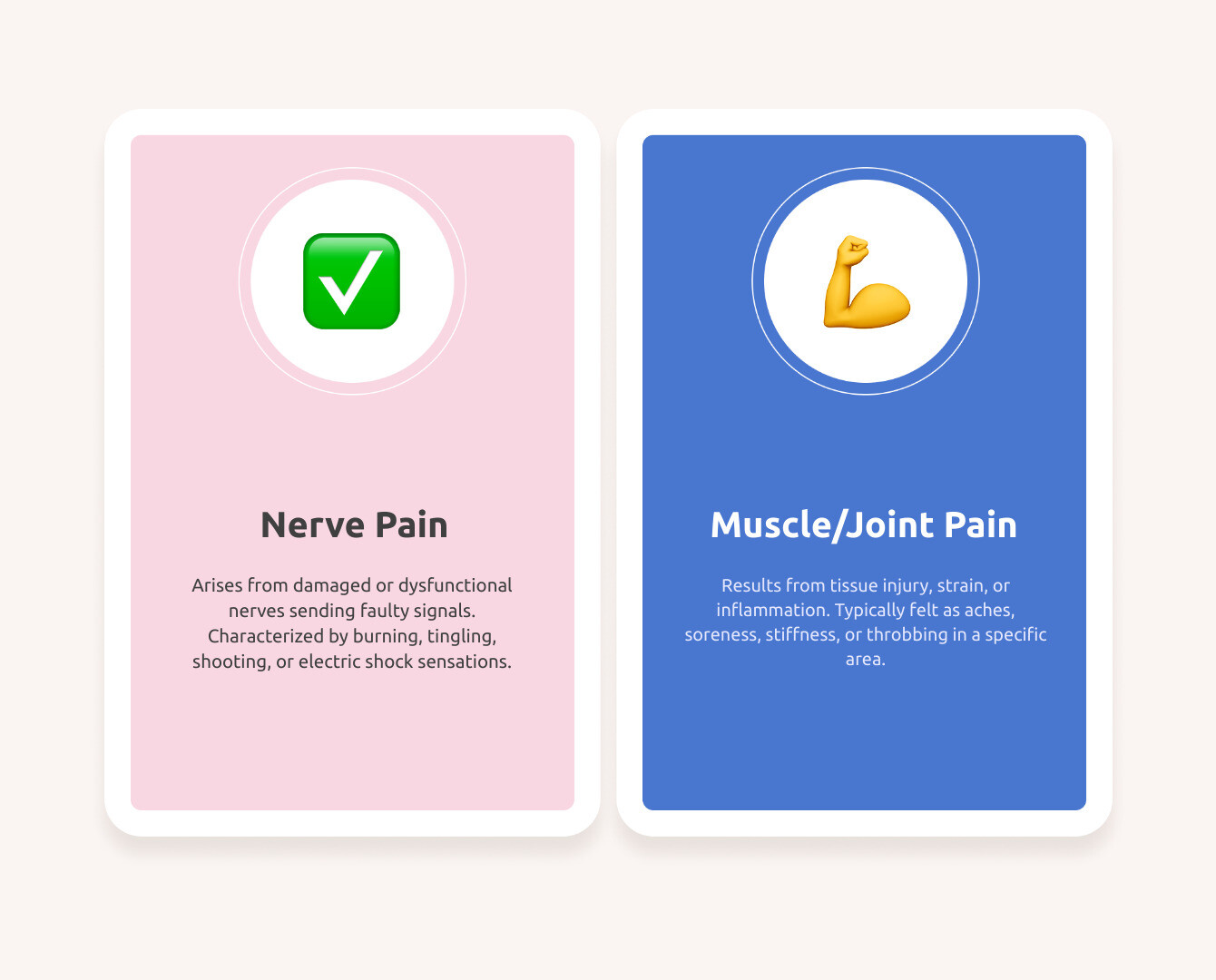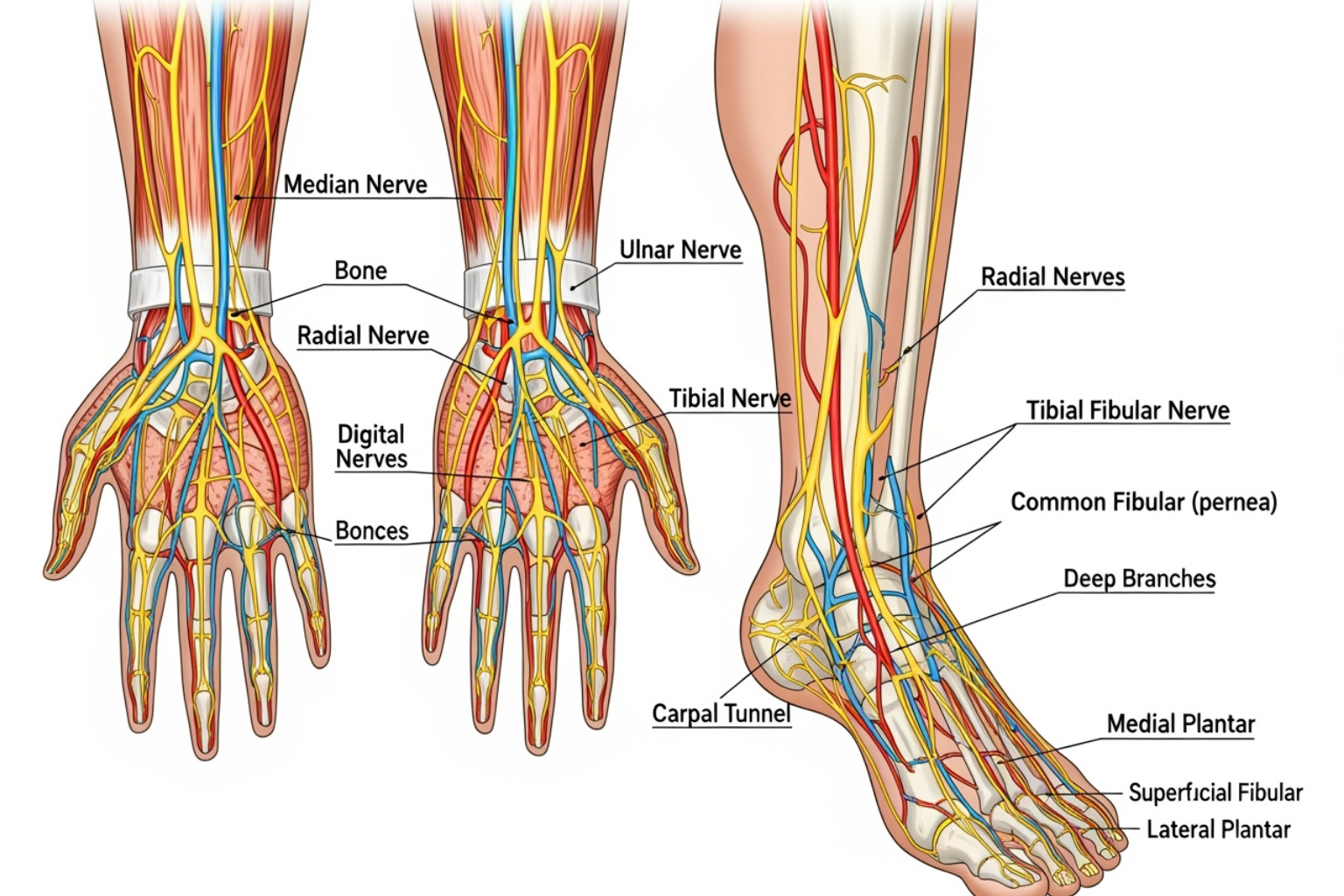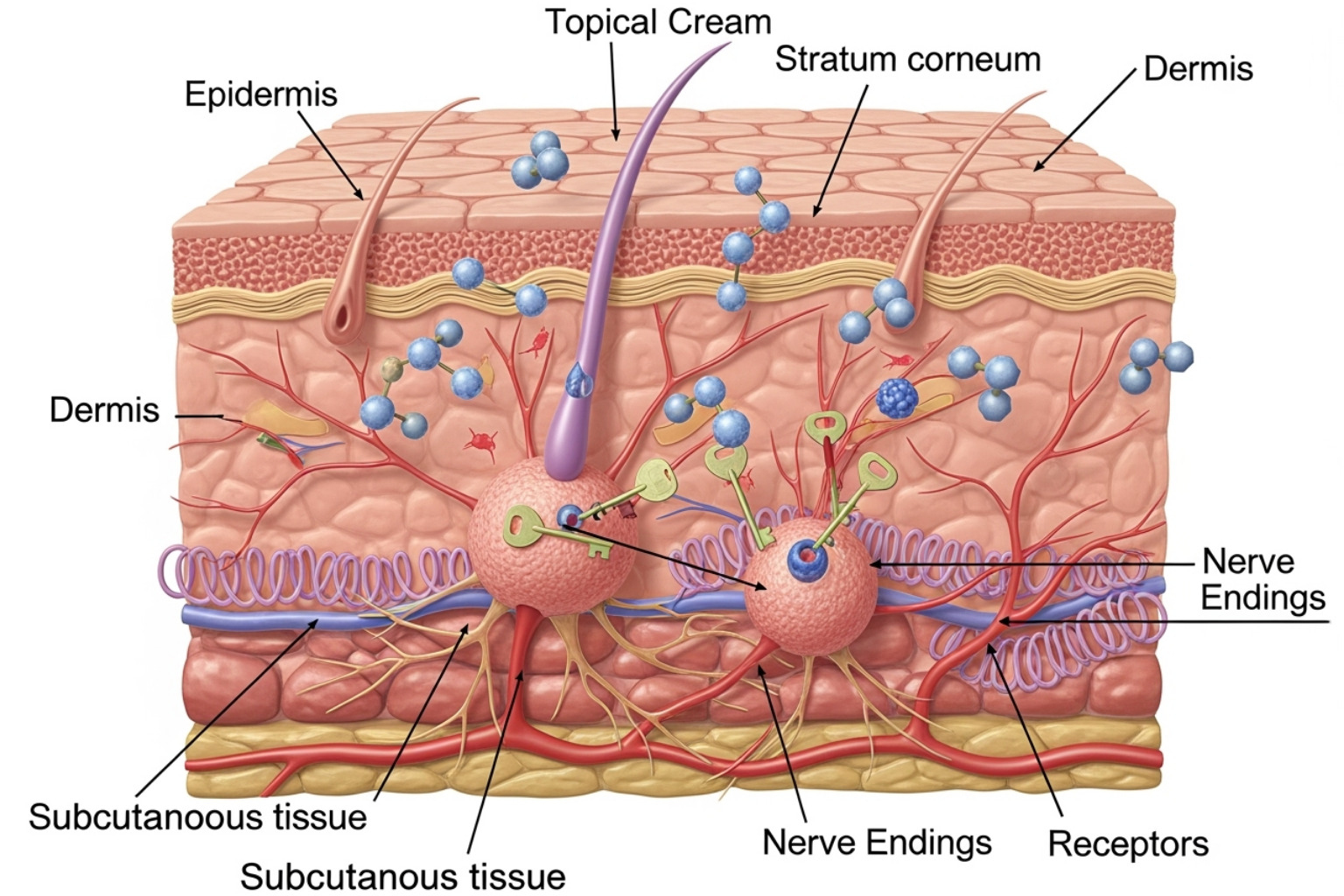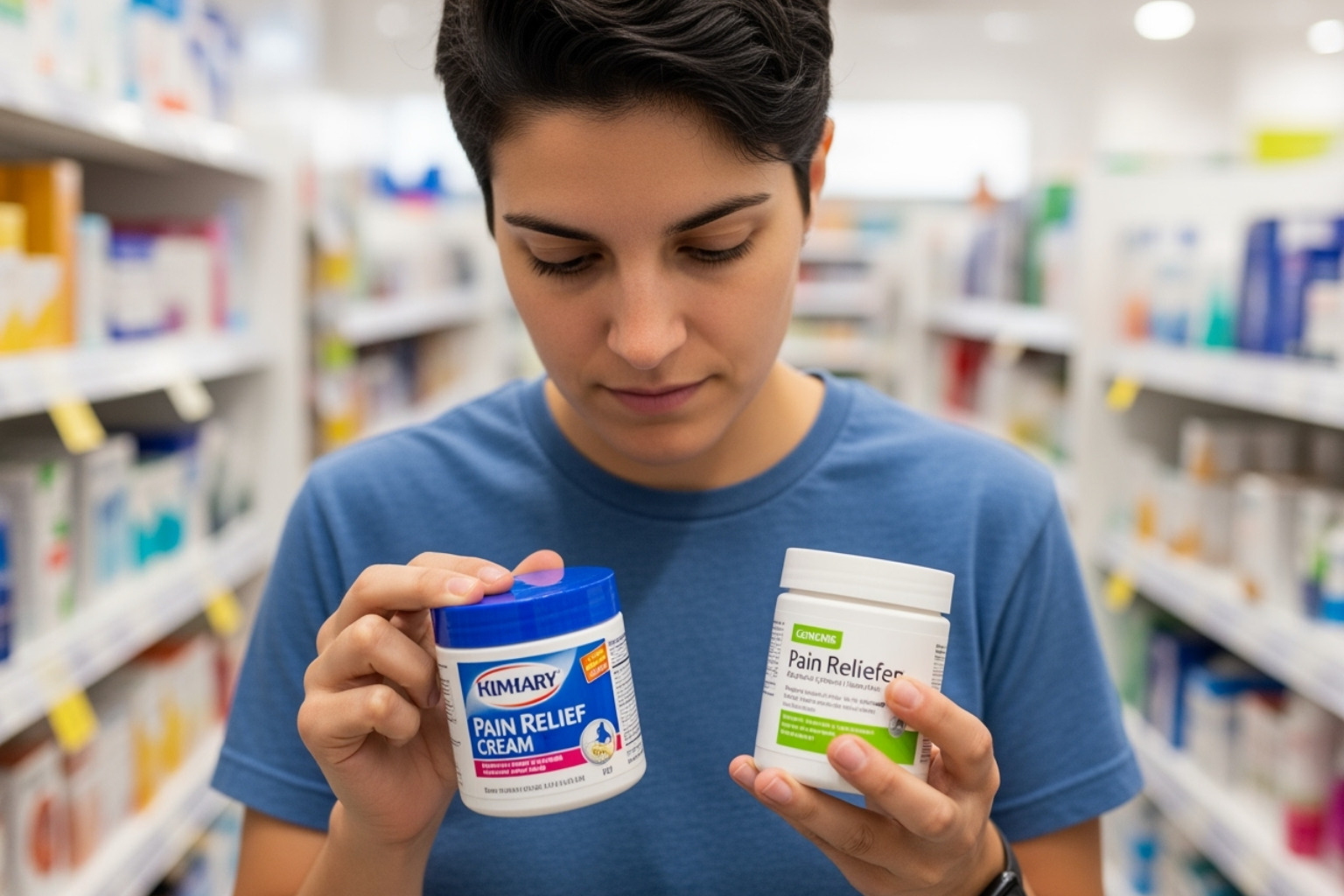Finding Relief from Nerve Pain: Your Complete Solution Guide
Nerve Pain Relief Cream provides targeted treatment for the burning, tingling, and shooting sensations of nerve pain. Unlike muscle soreness, nerve pain stems from damaged nerves and requires specialized topical solutions that interact with your body's pain receptors.
Quick Answer: Best Nerve Pain Relief Creams
- Menthol-based creams: Fast cooling relief.
- Capsaicin formulas: Long-term nerve desensitization (2+ weeks for full effect).
- Natural botanicals: CBD, arnica, and hemp seed oil for gentle relief.
- Lidocaine creams: Numbing action for surface nerve pain.
- Application: 3-4 times daily; wash hands after use.
Nerve pain originates from damaged or irritated nerves sending faulty signals to the brain, causing sensations like pins and needles or electric shocks.
Common causes include:
- Diabetes (diabetic neuropathy)
- Shingles aftermath
- Carpal tunnel syndrome
- Sciatica
- Chemotherapy side effects
With neuropathy affecting an estimated 3-17% of the population, effective topical treatments are essential for daily comfort.
This guide explains how nerve pain relief creams work, which ingredients to look for, and how to choose the right formula for your needs.
I'm Tony Enrico, and I've dedicated my career to developing advanced pain relief formulas like Neuropasil. Our cream combines natural ingredients like menthol, aloe, and panthenol for fast-acting nerve pain relief, helping people find effective solutions for their pain management routine.

Understanding Nerve Pain: Why It's Different

Regular pain from an injury, like touching a hot stove, is called nociceptive pain. It's your body's alarm system working correctly. Neuropathic pain is different; it's like a faulty alarm that goes off without a real threat. The nerves themselves are the source of the problem, sending confused signals to your brain.
Instead of a simple "ouch," nerve pain can feel like pins and needles, numbness, or electric shocks. Some people describe it as a burning or sandpaper-like sensation.
The causes are common. Diabetes is a leading cause, as high blood sugar can damage nerves in the hands and feet. The shingles virus can leave behind irritated nerves, causing pain long after the rash is gone. Injuries can pinch or damage nerves, while conditions like Sciatic Nerve Pain and carpal tunnel syndrome involve nerve compression.
This is a widespread issue. Research shows that neuropathy affects an estimated 3–17% of the population, meaning millions are seeking relief from these debilitating symptoms.
The Root of the Problem
Damaged nerves don't just stop working; they create their own chaos by sending misfiring pain signals. You might feel burning when nothing is hot or stabbing pain when nothing is sharp. Your nervous system gets stuck in a pain loop.
This is why we distinguish between acute and chronic nerve pain. Acute pain may fade as an injury heals, but chronic nerve pain becomes its own condition, with nerves remaining hypersensitive.
Frustratingly, typical pain relievers often fail because they are designed for inflammation, not for calming misfiring nerve signals. This is why specialized treatments like Nerve Pain Relief Cream are so important. They work directly with the mechanisms that cause nerve pain. Learn more in our guide: The Root of the Problem: Decoding Nerve Pain.
Q: How do nerve pain relief creams work to alleviate discomfort?
A: Nerve Pain Relief Cream works by delivering active ingredients through the skin directly to the nerve endings below. This targeted approach sends relief exactly where it's needed, bypassing the digestive system.
Once applied, the active ingredients penetrate the skin and interact with specific nerve receptors. Some ingredients create a "counter-irritant" effect, giving the brain a different sensation (like cooling or warming) to focus on instead of pain. Others work by blocking pain signals, reducing inflammation around irritated nerves, or desensitizing overactive nerve endings over time.
This local delivery method minimizes the systemic side effects often associated with oral medications. At Neuropasil, we've seen this targeted approach provide focused relief for conditions from diabetic neuropathy to sciatica, helping customers manage the burning, tingling, and shooting pains that disrupt daily life.

Q: What are the active ingredients in nerve pain relief creams and how do they work?
A: Understanding the active ingredients in Nerve Pain Relief Cream helps you choose the right formula.
- Menthol: A natural compound from mint, menthol creates an instant cooling sensation. It activates cold receptors in the skin, distracting the brain from pain signals. A 2015 study on menthol's effectiveness showed significant nerve pain reduction with topical use. We use menthol in Neuropasil for this immediate, refreshing relief.
- Camphor: This ingredient creates a gentle warming sensation, masking pain and promoting blood circulation. It works well with menthol as a counter-irritant.
- Capsaicin: Derived from chili peppers, capsaicin works by depleting Substance P, a neurotransmitter that sends pain messages. With consistent use, it desensitizes nerve endings. Research shows evidence for postherpetic neuralgia relief.
- Lidocaine: This ingredient provides a direct numbing effect by blocking nerve signals, which is helpful for pain close to the skin's surface.
Q: Are there any natural or homeopathic ingredients that are effective for nerve pain relief?
A: Natural ingredients offer gentler, botanical-based solutions for nerve pain.
- Cannabidiol (CBD): CBD interacts with the body's endocannabinoid system, which helps regulate pain. A 2020 study on topical CBD for neuropathy found that it significantly reduced sharp pain and other uncomfortable sensations.
- Arnica Montana: This herb has anti-inflammatory properties that can reduce swelling around irritated nerves and support circulation.
- Hemp Seed Oil: While it doesn't contain CBD, hemp seed oil is rich in fatty acids and vitamins that nourish the skin, creating a better environment for healing.
- Aloe Vera: Known for its soothing and moisturizing properties, aloe calms irritated skin and provides a cooling sensation. We use it as a key base ingredient in Neuropasil to improve comfort.
These botanicals work synergistically to provide a holistic approach to pain management. Learn more in our guide to Nerve Pain Relief with Neuropasil: Natural Solutions.
Q: What factors should consumers consider when choosing a nerve pain relief cream?
A: Choosing the right Nerve Pain Relief Cream depends on your specific needs. The most important first step is to talk to your healthcare professional. They can help diagnose the cause of your nerve pain and determine if a topical cream is an appropriate part of your treatment plan, especially for severe or worsening symptoms.
Your specific condition, the location and intensity of the pain, and your skin sensitivity are all key factors. If you have sensitive skin or conditions like diabetes that make skin more fragile, perform a patch test before full application.

Q: What should we look for on the label of a nerve pain relief cream?
A: Reading the label helps you make an informed choice.
- Active Ingredients: These are the primary pain-fighting compounds. Look for names like menthol (cooling), capsaicin (desensitizing), lidocaine (numbing), or natural options like CBD and arnica.
- Ingredient Concentration: Higher concentrations can offer stronger relief but may also increase the risk of side effects. A 4% lidocaine cream is much stronger than a 1% formula.
- Inactive Ingredients: These supporting ingredients can improve effectiveness and skin health. Look for moisturizers like Aloe Vera and Shea Butter, or absorption improvers like Urea. Neuropasil uses Aloe and Urea to help active ingredients penetrate better while keeping skin comfortable.
- Skin Sensitivity: Look for terms like "hypoallergenic" or "fragrance-free" if you have sensitive skin. Odor-free formulas are also available if you prefer a discreet scent.
Q: Are there any specific nerve pain relief creams recommended for conditions like neuropathy, carpal tunnel, or diabetic neuropathy?
A: Different nerve conditions often respond best to specific ingredients.
- Diabetic Neuropathy: This often affects the feet with burning and tingling. Creams with menthol for cooling, capsaicin for long-term relief, and anti-inflammatory botanicals like CBD and arnica work well. Moisturizing ingredients like aloe and urea are crucial for fragile diabetic skin. Learn more in our guide, Diabetic Neuropathy Explained: Navigating Nerve Pain with Diabetes.
- Postherpetic Neuralgia (Shingles Pain): This lingering pain often responds well to capsaicin creams, which gradually desensitize the affected nerves over time.
- Carpal Tunnel Syndrome: For this localized nerve compression in the wrist, lidocaine-based creams provide direct numbing relief. Menthol or camphor can also help with tingling.
- Sciatica: Since inflammation is a key factor, creams with anti-inflammatory ingredients like arnica can be helpful. Strong counter-irritants like menthol and camphor also work well for the radiating pain. Find out more on our Sciatic Nerve page.
The best cream depends on your symptoms and your healthcare provider's recommendation.
Q: How can nerve pain relief creams be used as part of a broader pain management strategy?
A: Nerve Pain Relief Cream is most effective when used as part of a complete pain management plan. It works as an adjunctive therapy, meaning it supports and improves other treatments.
For example, applying a cream like Neuropasil before physical therapy or a walk can reduce discomfort, making it easier to stay active. Many users find it acts as a "bridge," providing enough relief to participate in activities that support long-term nerve health. By managing pain topically, you're more likely to sleep better, exercise, and maintain a positive lifestyle.
Q: How do nerve pain relief creams compare to prescription medications for nerve pain?
A: Topical creams and oral medications offer different approaches to pain management. Creams provide targeted, localized relief, while oral prescriptions take a systemic, whole-body approach.
| Feature | Topical Creams (e.g., Neuropasil) | Oral Prescription Medications (e.g., gabapentin, duloxetine) |
|---|---|---|
| Target Area | Localized, direct application to the site of pain. | Systemic, affecting the entire body. |
| Speed of Relief | Often fast-acting (minutes for menthol/lidocaine). | Can take days or weeks to show full effect. |
| Systemic Side Effects | Minimal, primarily local skin reactions. | Potential for drowsiness, dizziness, nausea, etc. |
| Use Case | Mild to moderate localized pain; adjunctive therapy. | Moderate to severe widespread pain. |
Many people combine both, using a prescription as a baseline treatment and a topical cream for breakthrough pain. Always discuss prescription options with your healthcare provider, as medications like gabapentin are often considered first-line treatments for nerve pain.
Q: What broader strategies can complement the use of nerve pain relief creams?
A: Combining your Nerve Pain Relief Cream with other strategies often yields the best results.
- Physical Therapy and Gentle Exercise: Applying cream beforehand can make movement more comfortable, improving circulation and preventing muscle weakness.
- Diet and Nutrition: Foods rich in B vitamins, omega-3s, and antioxidants can support nerve health from within.
- Stress Management: Techniques like meditation and deep breathing can reduce muscle tension and how your body perceives pain.
- Sleep Quality: Applying cream before bed can help you find a comfortable position, as poor sleep can increase pain sensitivity.
- Lifestyle Modifications: Maintaining a healthy weight, quitting smoking, and limiting alcohol improve circulation and overall nerve health.
This comprehensive approach allows your cream to provide the immediate relief needed to pursue long-term healing strategies. Learn more at Everything You Need to Know About Neuropathy Cream.
Frequently Asked Questions about Nerve Pain Creams
Here are answers to the most common questions we receive about Nerve Pain Relief Cream.
How long does it take for nerve pain cream to work?
The time it takes to feel relief depends on the active ingredients.
- Menthol-based creams, like Neuropasil, offer a cooling sensation within minutes of application, providing fast comfort.
- Lidocaine creams also work quickly, typically numbing the area within 5-15 minutes.
- Capsaicin creams require patience and consistent use. The pain-relieving effect builds over several days to two weeks as it depletes the chemical messengers that transmit pain signals.
- Natural botanical creams (CBD, arnica) may offer some immediate soothing effects, but their full anti-inflammatory benefits often build over several days.
Manage your expectations based on the ingredients and follow the recommended routine.
Are there any side effects I should be aware of?
Topical creams generally have fewer side effects than oral medications because they act locally.
- Capsaicin can cause a temporary burning or stinging sensation, which usually lessens with continued use. Always wash your hands thoroughly after application to avoid contact with your eyes.
- Menthol and camphor create cooling or warming sensations that most find pleasant, but they can be irritating to very sensitive skin.
- Lidocaine may cause temporary numbness or mild skin irritation.
Allergic reactions (rash, severe itching, swelling) are rare but possible. Always perform a patch test by applying a small amount to your inner forearm and waiting 24 hours to check for a reaction. If you experience a severe reaction, stop use and consult your healthcare provider.
Can I use a nerve pain relief cream every day?
Yes, most Nerve Pain Relief Creams are designed for daily use, and consistency is often key to achieving the best results. Formulations like Neuropasil are typically applied 3-4 times per day to maintain steady relief for chronic conditions like neuropathy or sciatica.
For long-term daily use, especially if you have other medical conditions or are taking other medications, it is wise to consult your doctor. They can provide personalized advice and ensure the cream is a safe part of your routine. Always follow the product's specific directions.
Conclusion: Taking the Next Step Towards Relief
We've seen that nerve pain, with its distinct burning and tingling sensations, requires a different approach than muscle soreness. Nerve Pain Relief Cream offers a powerful, targeted solution.
The benefit of topical treatments is their ability to deliver active ingredients—like cooling menthol, desensitizing capsaicin, or natural botanicals like CBD and arnica—precisely where you hurt.
Choosing the right cream means matching the ingredients to your specific condition, whether it's diabetic neuropathy, sciatica, or carpal tunnel syndrome. However, topical creams are most effective as part of a holistic approach that includes gentle exercise, proper nutrition, and stress management.
At Neuropasil, we understand you're looking for a way to get your life back from nerve pain. Our natural formulations, powered by Aloe, Urea, and Menthol, are crafted to provide fast, soothing comfort. We designed our cream to fit seamlessly into your daily routine, helping you manage discomfort and stay active.
Your journey toward relief starts now. Experience the difference that targeted, natural care can make in your daily life. Explore natural nerve pain relief with Neuropasil Cream and reclaim the activities that matter most.
With the right tools and support, relief is within reach.
References
The research and evidence presented throughout this guide comes from peer-reviewed studies and medical literature that help validate the effectiveness of Nerve Pain Relief Cream and topical treatments for neuropathic conditions.
Cavalli E, et al. (2019). The neuropathic pain: An overview of the current treatment and future therapeutic approaches. This comprehensive review provides crucial insights into how neuropathy affects 3-17% of the population and outlines evidence-based treatment approaches. You can access the full study at https://www.ncbi.nlm.nih.gov/pmc/articles/PMC6431761/
Derry S, et al. (2017). Capsaicin (8%) patch for neuropathic pain in adults. Cochrane. This systematic review examined the effectiveness of capsaicin for conditions like postherpetic neuralgia following shingles outbreaks. The research demonstrates how capsaicin works by depleting Substance P to provide lasting nerve pain relief. Available at https://www.cochrane.org/CD007393/SYMPT_capsaicin-applied-skin-chronic-neuropathic-pain-adults
Fallon MT, et al. (2015). Cancer treatment-related neuropathic pain: proof of concept study with menthol—a TRPM8 agonist. This important study showed how 1% topical menthol applied twice daily effectively reduced nerve pain in cancer patients, supporting the use of menthol-based ingredients like those in Neuropasil. The research is accessible at https://www.ncbi.nlm.nih.gov/pmc/articles/PMC4519585/
Xu DH, et al. (2020). The effectiveness of topical cannabidiol oil in symptomatic relief of peripheral neuropathy of the lower extremities. This promising small-scale study with 29 participants demonstrated that topical CBD oil significantly reduced intense nerve pain sensations without adverse side effects after 4 weeks of use. Read the complete findings at http://www.eurekaselect.com/article/102689
These studies form the scientific foundation supporting the ingredients and approaches discussed in this comprehensive guide to nerve pain relief. They represent ongoing research efforts to understand and improve treatments for the millions of people living with challenging neuropathic conditions.















